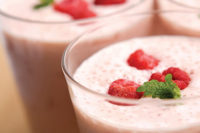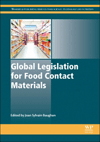Processors can gain an advantage with protein fortification

Blended protein beverages that combine cow’s milk with plant proteins might attract new consumers and enable unique positioning in the marketplace. Photos courtesy of Glanbia

Milk and yogurt naturally contain dairy protein. Both products can be fortified with additional protein.

A protein-fortified cereal bar might be one way to help Americans consume adequate quantities of protein.



Our panel of experts
- Agropur Ingredients, La Crosse, Wis.: Aaron Martin, research and development; Kyle Frank, protein technical representative; and Corrie Reilly, marketing and communications
- Arla Foods Ingredients Group, Basking Ridge, N.J.: Cheryl Reid, account manager, sports, health and performance
- Davisco Foods International, Eden Prairie, Minn.: Phanin Leksrisompong, former director of business development
- DuPont Nutrition & Health, New Century, Kan.: Meagan Keepes, marketing specialist
- Glanbia Nutritionals, Evanston, Ill.: Vicky Fligel, business development manager
Consumers are more aware of protein’s health benefits than ever before, but what exactly do they know and how does this knowledge translate to purchases of protein-containing products? Here, ingredient suppliers share their insights regarding consumers’ perceptions about protein, health and nutrition. These insights can inform the industry’s plans for product formulations, consumer education, and product positioning. Dairy Foods’ Health & Wellness Editor Karen Giles-Smith conducted an e-mail roundtable with some leading providers of protein.
Dairy Foods: Many consumers don’t know how much protein they need and therefore don’t know how to determine if a serving of a food or beverage contains a little protein or a lot. With this in mind, what are your suggestions for ways to highlight protein content on product packaging?
Agropur: A fair number of marketers do communicate the protein amount per serving to consumers. While this is very encouraging, it could and should evolve into something even more valuable. Understanding the impact that various proteins have on the human body will be important to help consumers choose which products to consume, when and maybe even why. For example, consumers need to know that not all proteins are created equal and to achieve ideal muscle building, amino acid absorption and satiety performance, the average person should consume approximately 15 to 20 grams of protein per meal.
We would like to see companies promote the origin of proteins (such as whey, casein, pea, rice, soy, quinoa, etc.) and potentially list a percentage of daily recommended protein per serving. In marketing campaigns, it would be smart to highlight benefits by using key words like “satiety” or “muscle-building.” Consumers are looking for healthy, great tasting, mobile and convenient products. They should be able to identify, on-the-go, what part of their nutritionally balanced regimen is covered by consuming X amount of a certain product.
Leksrisompong: We need to provide nutrition facts on the product package that are more visual and easy to understand. However, the dietary guideline must be set correctly. Current protein requirements are set at a minimum level established to prevent deficiencies (0.8 grams/kilogram body weight/day), not for optimum health.
Reid: Determining the amount of protein to recommend for a food is very difficult as you don’t know what other foods (containing protein) a person is eating and their particular protein needs. In general, healthy adults need 45 to 57 grams of protein, depending on physical activity. To help consumers decide if a particular product is a good source or not, highlighting the amount of protein as a percent of RDA is always best. Label claims such as “good source” or “excellent source” are also excellent ways to highlight these facts.
Fligel: A good source of protein contains from 10% to 19% of the daily value of protein, while a high source provides more than 20%. With five grams of protein, most milk and cheeses can be considered a good source of protein, while Greek yogurts, with 10 grams of protein, qualify as an excellent source of protein and are marketed as “high in” or “rich in” protein. Comparative claims such as “a serving of milk has as much protein as an egg” or “two times the protein of standard yogurt” provide perspective.
Dairy Foods: Do you think that promoting a product based on the quality of the protein it contains would be a beneficial marketing tactic?
Reid: Yes; absolutely. Not all proteins are complete; therefore some proteins give very little value to the body. “Completeness,” and therefore the value of a protein, is measured by the composition of essential amino acids. Whey protein has high levels of all of the essential amino acids, making it the highest-quality protein.
Keepes: Currently protein quality is not well understood by consumers. However, as consumers become more knowledgeable about protein, the differences in quality among proteins will become a more important differentiator. The Protein Digestibility-Corrected Amino Acid Score (PDCAAS) is an accepted international standard for assessing the quality of food proteins, and the standard [the Food and Drug Administration] has adopted for protein labeling. Using PDCAAS as a reference, soy protein is the only commercially viable plant protein considered a high-quality protein, equivalent in protein quality to milk and egg proteins.
Leksrisompong: It depends on the target market. If targeting health-conscious individuals who have high knowledge of nutrition and high willingness to change their diet to achieve health benefits, then it’s a great way to differentiate the products. This particular market sector understands that not all proteins are created equal nutritionally; proteins do not have the same quality. However, it will be important for food manufacturers to educate all consumers about protein quality.
Dairy Foods: When choosing foods and beverages based on protein content, do consumers prefer products that naturally contain protein (such as milk, yogurt and cheese) over protein-fortified products? And what are consumers’ perceptions about products that naturally contain protein and also contain added protein (such as protein-fortified milk)?
Agropur: We have witnessed an extremely positive reaction to naturally containing and protein-fortified products alike. We’ve also seen positive reactions to protein-containing products that contain additional protein. For instance, protein-enhanced Greek yogurt is available in a variety of protein levels and there is an audience at both ends of the spectrum. Protein content, as well as taste and consistency, has a big influence on consumers’ purchasing decisions. Of note is that nutrition experts recommend balancing food choices between naturally containing and fortified products.
Reid: In general, consumers are aware of protein and are looking at labels for total protein content. Most consumers are not aware of how much or little protein is in products such as meat and eggs, because these whole foods are not labeled with a nutritional panel. Dairy products do have nutritional labeling, therefore giving an advantage.
Keepes: Consumers’ choice of foods naturally containing protein versus fortified is dependent on many lifestyle factors and is often an occasion-specific choice. Consumers with active, busy lifestyles may prefer protein-fortified foods at certain points of the day as they may be more convenient and portable. Consumers on high-protein diets may also prefer protein-fortified foods and beverages.
Fligel: Consumers looking for protein fortification are aware of the challenges of consuming high amounts of proteins from food’s natural content. Research recommends an optimal serving of 20 to 30 grams of protein per meal, and protein-fortified products make it much easier to consume this amount. Despite consumers’ acceptance of protein-fortified products, clean label is a key factor in their choice.
Dairy Foods: Do you think that products containing protein blends (such as whey and soy, or pea protein and soy) will be successful in the market long-term?
Reid: Yes, they are and will continue to be. Consumers are looking for total protein. The average consumer is price-sensitive and therefore will likely choose products that are equal in total protein but are cheaper (which blends generally are).
Agropur: There are two major reasons a manufacturer would use a protein blend: to create a product that performs better or to consolidate costs. When blends are created with integrity to help to improve product functionality or nutrition, we can foresee that being a successful endeavor in both the sports nutrition and mainstream marketplace.
Leksrisompong: Yes, future products are likely going to be made from blends of high-quality animal proteins (e.g., whey protein) and lower-quality and less expensive plant proteins (e.g., soy, pea or rice). The food industry will be challenged to deliver products with optimum nutritional and economic value of protein to feed a growing and aging population. At the same time, consumers’ demand for convenience, taste, texture and cost must be met, as well as considering environmental impact and sustainability.
Keepes: Blending soy and dairy in particular has become a popular formulation trend in high-protein beverages and foods in recent years. The benefits of blending include:
- Cost. Soy protein is generally more economic than dairy proteins.
- Flavor synergies of blends. Sensory research has demonstrated that blends of dairy and soy proteins often perform better in consumer liking than similar products formulated with either all soy or all dairy proteins.
- Emerging nutritional benefits. More research is being focused on understanding the nutritional benefits of blends of proteins. For instance, recent research has shown that blends of dairy and soy are more effective in extending the window post-exercise when muscle building can occur compared to an all whey protein control.
Fligel: It depends on the consumer group. For price-conscious consumers, a dairy, soy or pea blend is the perfect solution. At the same time, an increasing number of consumers are looking for vegan options and are seeking grain, soy and pea proteins as valid alternatives. New ingredients like flax protein, chia protein and ancient grain protein are also coming on line to expand plant protein sources. Because dairy-allergen-sensitive consumers are turning to alternative sources, vegan sources of protein provide fortification options for everyone.
Dairy Foods: Now that protein is being added to low-protein milk-alternative beverages such as almond milk, are fluid milk sales in greater danger? How can cow’s milk win back consumer favor?
Agropur: This relates to the origin of the protein and what benefits that particular source imparts to human nutrition. Whey protein, for instance, has the ability to quickly deliver essential amino acids to the blood stream; contains high levels of leucine which helps aid in the repair, rebuilding and maintenance of muscles; aids in immunity; and has detoxification properties. We encourage manufacturers utilizing dairy-derived protein to use this information to help promote their products. Also, there is a place for alternative proteins in the food industry. As with all health-minded products, the goal should always be to provide the highest level of quality possible and, at the same time, fit within whatever the demographics’ existing boundaries may be.
Reid: Fluid milk sales have been suffering for many years as it was not “cool” to drink milk. Marketing programs such as the promotion by athletes of chocolate milk as a recovery product and the “got milk?” campaign have bolstered milk sales. More promotion around the protein content and quality of fluid milk will maintain milk as a healthful choice. The “new milks” such as filtered, low-lactose, flavored, etc., have given consumers more choices.
Leksrisompong: Consumer education is the key. Many consumers often turned away from milk consumption because of misinformation or misguided perceptions about specialized diets. Now, many consumers are trying to “eat clean” by switching from regular milk to milk-alternative beverages. However, many do not realize that milk alternative beverages typically contain stabilizers (e.g., locust bean gum, guar gum, and carrageenan).
Keepes: There are tremendous opportunities for dairies to explore innovative ways to leverage the growing popularity of plant-based proteins, while increasing opportunities for cow’s milk too. The notion of blended protein beverages, combining cow’s milk with plant proteins, may attract new consumers and enable unique positioning in the marketplace.
Fligel: Innovation and fortification are key to bring consumers back to milk. Fortified milk allows more health- and sports-conscious consumers to utilize dairy ingredients as their main protein source. Low-protein options are a good solution for a nondairy audience, but cannot replace all the nutritional benefits of fluid milk.
Dairy Foods: Some believe that promoting the muscle-preserving benefits of protein to the aging population is a hard sell. Perhaps aging consumers don’t want to acknowledge that they are getting old and that their muscle mass is decreasing. Do you have any suggestions for promoting protein’s benefits to this age group?
Agropur: With the aging population, we don’t necessarily agree that protein is a hard sell because of resistance. If there are obstacles, we would more likely identify them in the realms of communication or knowledge.
Much like the general population, the aging community knows that protein has benefits but it is probable that the optimal amount for consumption is not fully comprehended. This needs to be communicated through various outlets, as the aging population isn’t quite as digitally advanced as the younger generations — at least on the mobile end. This means marketers need to get the word out on multiple platforms. Bottom line: A clearly labeled product, with a diversely communicated marketing campaign that launches with a creative pricing promotion could hold the best potential for a success in this demographic.
Reid: Marketing is a powerful tool. In Asian countries, particularly Japan, age-related muscle loss is common knowledge and consumers adjust their lifestyles (diet and exercise) to combat this fact. Our medical community needs to be educated on sarcopenia (age-related muscle loss) and the simple dietary changes that aging people can do to improve their situation.
Keepes: The evidence is mounting that protein needs do increase in aging and that protein intake should be more evenly spread out throughout their day for maximum benefit, not just centered in the evening meal.
Based on the developing science in this area, we believe that it is only a matter of time before this concept catches on with consumers, opening up tremendous opportunities for the food and beverage industry. According to Euromonitor, sales of protein supplements in the United States experienced 24% growth in 2013. Much of this growth is attributed to active, aging consumers becoming more aware of the benefits and need for protein as they age and choosing daily protein supplements as a means to boost their daily intake.
Dairy Foods: What else should we know about protein fortification?
Leksrisompong: Protein has become a buzzword with consumers and many food companies are taking advantage of this opportunity with new products or simply adding a few additional grams of protein to an existing product to get a protein claim on the label. Many of these products contain as little as 5 to 10 grams of protein. These supplements are likely too low in protein for any nutrition benefit.
When fortifying with protein, the manufacturers should be held responsible to deliver products with optimum amounts of protein. The minimum effective protein dose is at least 2.5 grams of leucine or about 20 to 30 grams of protein, depending on the protein quality.
Looking for a reprint of this article?
From high-res PDFs to custom plaques, order your copy today!












